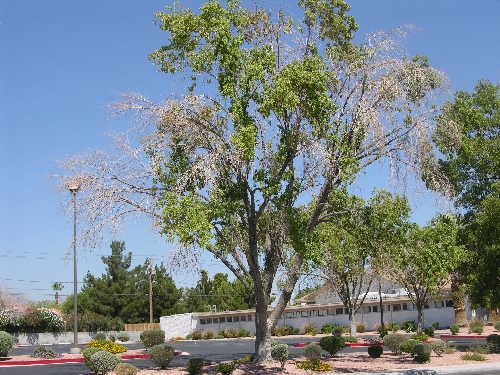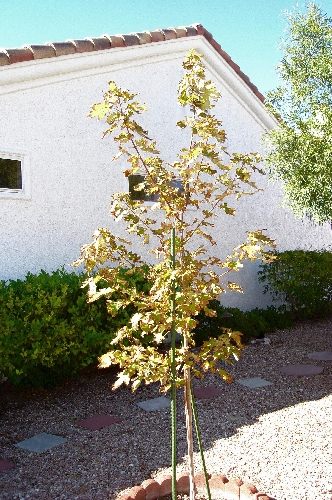Hybrid maple tree not suited to desert climate
Do you want to plant some fruit trees? The University of Nevada Cooperative Extension Master Gardener Orchard in North Las Vegas is ordering bare root fruit trees for planting next spring. These are varieties that have done well at the orchard with the fruit going to local restaurants and chefs. You can find out what trees are available and order trees by emailing me at extremehort@aol.com
Q: I enclosed pictures of a little sapling from North Carolina I bought online in March 2010. Several months ago all the leaves turned brown on their edges only. Now the tree is burned to a crisp all over. Is it too much water or not enough? We live in Sun City Summerlin.
A: Thank you for knowing and remembering what plant you bought and its name. This helps me a lot in tracking and learning about this plant before I responded. Autumn Blaze maple was hybridized by an Illinois nursery in the 1980s.
In the Midwest or other suitable climates such as the East Coast or Pacific Northwest, it will grow to a height of 60 feet and 40 feet wide. It is called Autumn Blaze caused of its splendid red and orange fall colors that can be seen in those parts of the country and I'm sure this is why you selected it.
This is a case where you have chosen a tree that is just not suitable for our soils or our climate. This particular maple tree is a hybrid between silver and red maples, both of which struggle in our alkaline, saline soils and extremely high temperatures. A tree with these two parents in its lineage doesn't have much of a fighting chance in our desert environment.
The pictures you sent me show that it is already struggling here, which is evidenced by its scorching leaves. Both parents of this tree are highly susceptible to iron chlorosis and would need treatment for this problem, even if you could get it healthy. I'm sorry to give you the bad news but this is a tree that should not be grown here.
Q: I am writing because of a problem I have with my 20-year-old, long-needled pine (I forgot the name). The needles are 6-7 inches long and fluffy. When I converted my lawn to drip, the pine began to turn brown in several areas. I added more and more drippers. After four years, this poor pine, once a beautiful, fluffy tree, is now in serious trouble.
Many small branches and a few medium-sized ones have died back. Every spring, it has rallied and I think it will be OK, but by the end of the summer it looks very sad. Is there anything more I can do to save this tree?
A: I am guessing you have Chir pine. This pine is beautiful and does very well here provided it gets enough water and at the right times. When they are growing in a lawn, their roots can extend long distances from the trunk and typically close to the soil surface.
If they were growing in a turfgrass landscape converted to desert (drip), they frequently do not get enough water after the conversion. They first suffer needle drop resulting in a thinned canopy, needle tips turn brown, growth slows and then limb dieback begins. I think this is what is happening to your tree .
The water previously supplied when watering the lawn is frequently substituted with six to eight drip emitters placed fairly close to the trunk. You will need to provide more water to the tree and in many more locations to compensate.
These are big trees and big trees require lots of water, even if they are considered lower in their water use than other large trees. There is no research to tell us how much water this tree will require during an irrigation, but I would assume it would probably be in the 100-gallon range or more per irrigation, evenly distributed over its root system.
I don't think that trees that get more than 20 feet tall should be on drip; they should be on bubblers with a basin (depression or moat) surrounding the trunk. This depression should be large enough to hold enough water to keep the tree in good health and penetrate to a depth of 24 inches after an irrigation.
Some people have suggested using inline drip irrigation in concentric rings around the trunk. Perhaps. But devices do not apply water, people do and people must make the decision about how much to apply and where to apply it. Drip irrigation can be deceiving because it takes hours to irrigate instead of the minutes we are used to when we water a lawn.
Another possible approach would be to plant other plants heavily under the dripline of the tree for additional water. No one likes to do this because you have to fight with tree roots to plant.
To save the tree you need to be proactive now. Apply water under the canopy to a depth of about 24 inches during each irrigation. Couple this with an application of fertilizer next February. You will not see improvement at this time of year as most trees are going into dormancy. With properly placed deep irrigations you should see a change next year during the growing season. You should see a big change in 2013.
As it sounds to me, if you do not change your irrigation system and how you are watering, you will lose the tree. We have lost many trees in this valley when landscapes are converted to desert landscapes principally because the irrigation systems supplied to established large trees are underengineered. Most people do not understand this or will not do it right because it is "too expensive."
Bob Morris is a horticulture expert living in Las Vegas. Visit his blog at xtremehorticulture.blogspot.com.


















